9 Locomotion
Limbed locomotion on land
Limbed lizards and salamanders as well as crocodilians retain the sprawling posture of early land tetrapods. The limbs of a typical lizard or salamander bend at 90 degree at the elbow and knee. The proximate part of the limbs (humerus on forelimbs and femur on hind limbs) lies more or less parallel to the ground while the distal parts (ulna/radius on forelimbs and tibia/fibula on hind limbs) sit perpendicularly to the ground. The sprawling posture contrasts with the erect posture of mammals in which the entire limb is perpendicular to the ground.

Tetrapods descend from fish that swam by bending their bodies from side to side and many amphibians and reptiles retain this lateral bending as they move. When a typical lizard or salamander walks on land, one foot is lifted and brought forward while the other three remain in contact with the ground. Raising one foot affects the stability of the body in the same way that cutting a leg on a chair does. If you cut one leg on a chair, it will topple over the missing leg.
When a lizard rests on all fours, its center of mass falls somewhere inside the square formed by the four feet and the lizard is stable like a chair with four legs. If a limb is lifted, the center of mass moves outside the triangle formed by the three contact points and the lizard becomes unstable like when and leg is cut off a chair. Bending the body when a foot is lifted off the ground moves the center of mass away from the side of the body with only one foot remaining on the ground and brings it inside the triangle formed by the three feet still on the ground.

In the diagram above, the feet touching the ground form the red triangle. The center of mass is indicated by the red dot. When the center of mass is outside the triangle, the body is unstable and will tip towards the center of mass. By bending the body, the center of mass is moved inside the triangle and the body remains stable. Bending the body from side to side during locomotion keeps the body stable.
Bending the body during limbed locomotion also serves another purpose. It increases the reach of each step and thus increases the length of the stride.
A few species of lizards are capable of bipedal locomotion. Bipedal locomotion is typically used to sprint away from predators although the Australian Frilledneck Lizard (Chlamydosaurus kingii), runs on two legs to charge predators or rivals. The Basilisk (Basilicus sp) lizard from Central America took bipedal locomotion to an extreme. This species is sometimes called the Jesus Christ Lizard because it can run on water to escape predators.
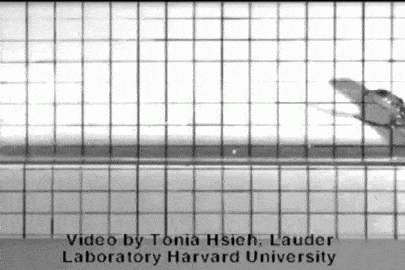 Turtles can’t bend their body from side to side because of their stiff shell but they manage to remain somewhat stable during locomotion, thanks to their broad body and slow movements. Turtles nonetheless tend to fall forward as they walk. The inability of turtles to bend their body limits the length of their stride but recent research has showed that turtles have a movable pectoral girdle, and its movement increases stride length.
Turtles can’t bend their body from side to side because of their stiff shell but they manage to remain somewhat stable during locomotion, thanks to their broad body and slow movements. Turtles nonetheless tend to fall forward as they walk. The inability of turtles to bend their body limits the length of their stride but recent research has showed that turtles have a movable pectoral girdle, and its movement increases stride length.

Despite these adaptations, turtles remain slow on land. The turtle shell is mostly made out of bone which is a heavy tissue. The mass of the skeleton can account to up to 40% (range: 2.4 to 40%) of the body weight of a turtles (compared to about 14% in humans). That’s the equivalent of a 70Kg (150 lbs) human having to carry a 18Kg (40 lbs) backpack. Hauling this bony mass certainly slows turtles down at least on land. In addition to being heavy, the shell is also in the way of the limbs. In most vertebrates that walk on all four, the elbow points backward or sideway (think of a dog, a lizard or you doing push-ups). In turtles, the elbows point forward! That’s because the shell is preventing the forelimbs to come out on the sides. Instead, they come out at the front front of the shell. To picture how the shell affects the orientation of the limbs, imagine you have to walk on all four BUT you have to wear a stiff cylinder around your torso that goes up to your chin with your arms coming out at the tip. That is more or less how the forelimbs of turtles are arranged.
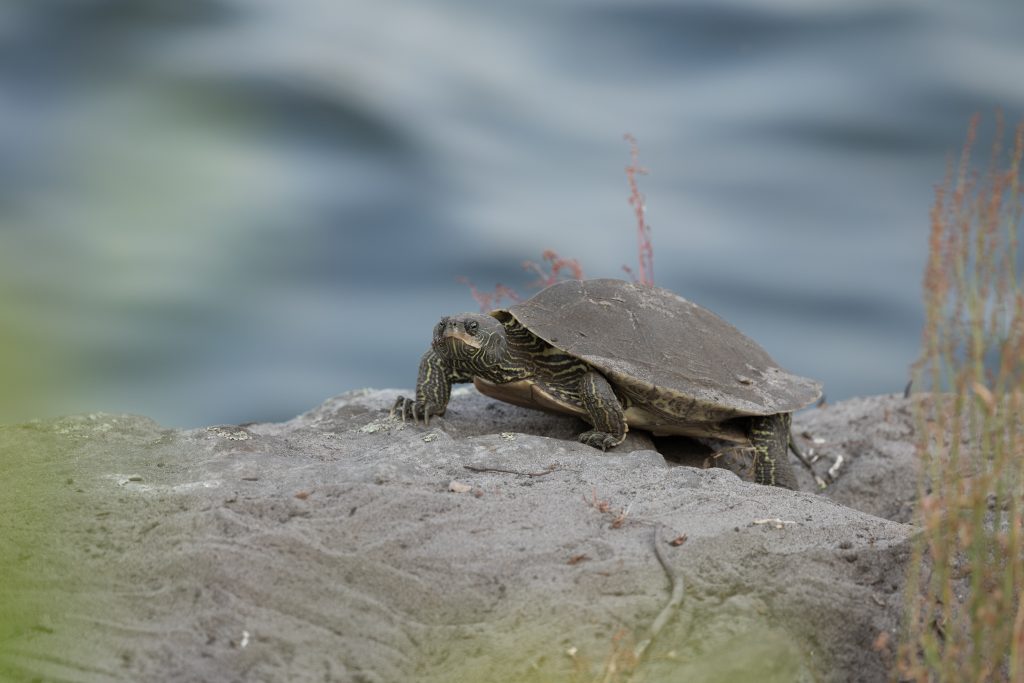
Jumping in frogs
Many herps can jump but frogs are the real jumping champs of the herp world. For instance, the Australian striped rocket frog (Litoria nasuta) can jump a distance equivalent to 64 times its own body length in a single jump. For comparison, the world record for distance jumping was achieved in 1991 by Mike Powell. He jumped a distance of 8.95 meters or 4.8 times his height.
The skeleton of frogs is heavily modified, and while not all species of frogs leap, many of these modifications may be adaptations to leaping. When looking at a leaping frog (think of a northern leopard frog), the most obvious aspect of its morphology is its huge hind limbs. The hind limbs is where the propelling power comes from. The bones forming the hind limbs are elongated compared to a typical tetrapod. The fibula and tibia are fused together, forming a tibiofibula, which probably adds stiffness to the elongated bones.

Look at the hind legs of a frog sitting on the ground. The legs have four segments and bend in three spots. This is different from our legs which have three segments (femur + tibia/fibula + ankle/foot) and bends in two spots (knee and ankle). The extra segment in frogs is formed by two angle bones (astragalus and calcaneum). These bones have become their own leg segment and can move independently from the rest of the ankle. The digits of the hind feet are also elongated, at least in jumping species.
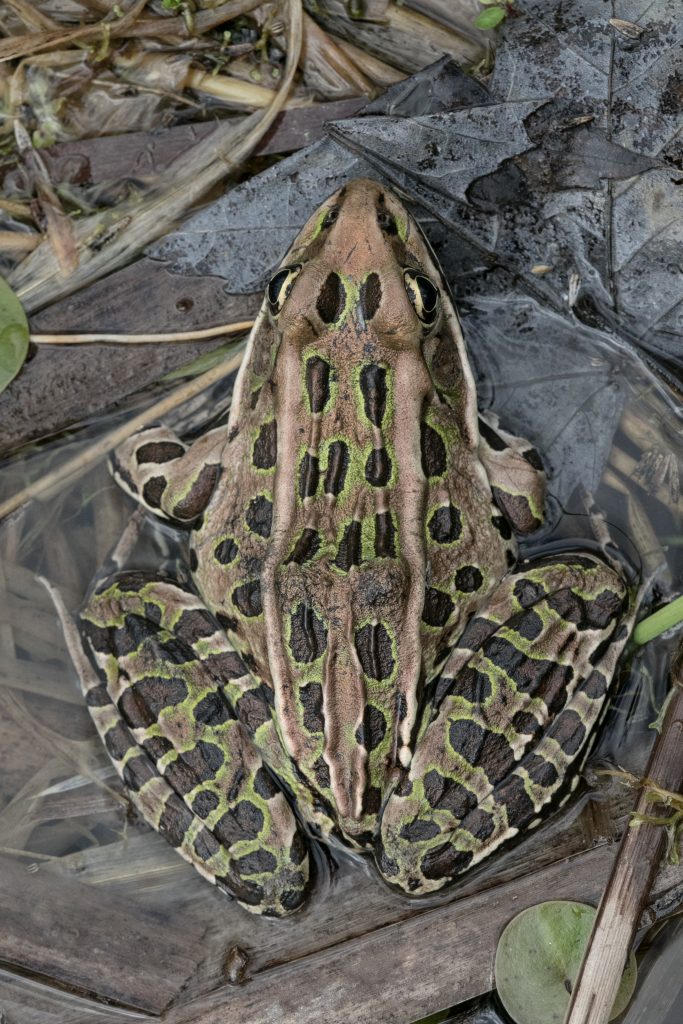
These long bones are associated with huge leg muscles. Many of the thigh muscles attach to the ilia (singular: ilium) which are enlarged to provide a large attachment surface. The tail vertebrae are fused into a long rod called the urostyle which rests between the ilia. Both ilia and the urostyle articulates with the sacral vertebra forming the sacroiliac joint. You can see this joint in a frog at rest. It is the conspicuous bump on its back. In a leaping frog in mid-air, the bump is not longer visible because the vertebral column and ilium bone are aligned. The sacroiliac joint has recently been suggested to help frogs fine tune their jumping trajectory.
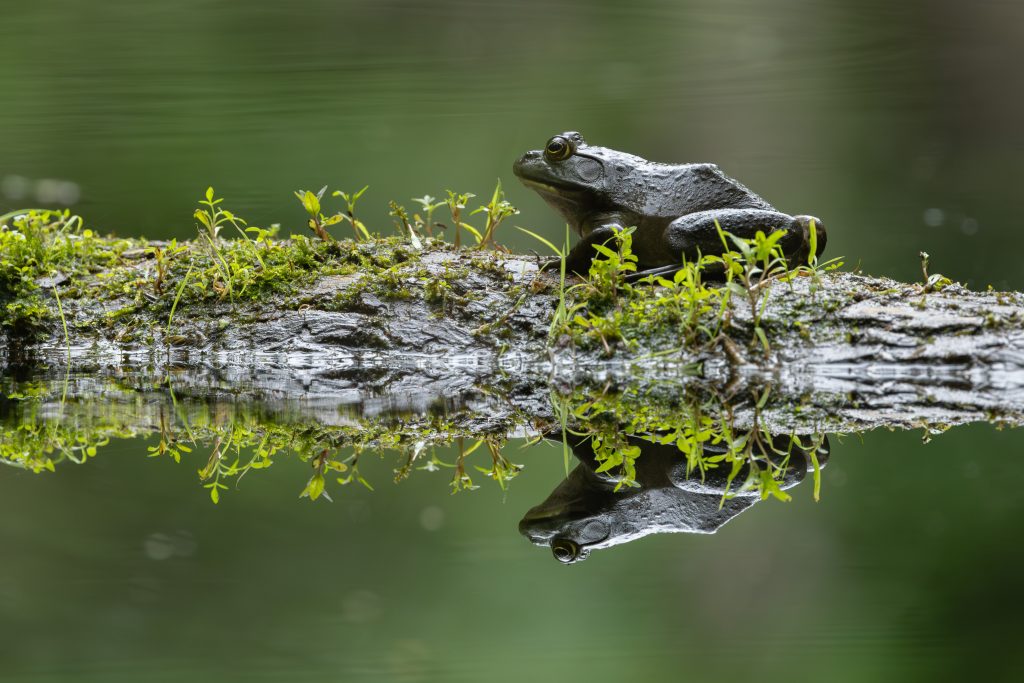
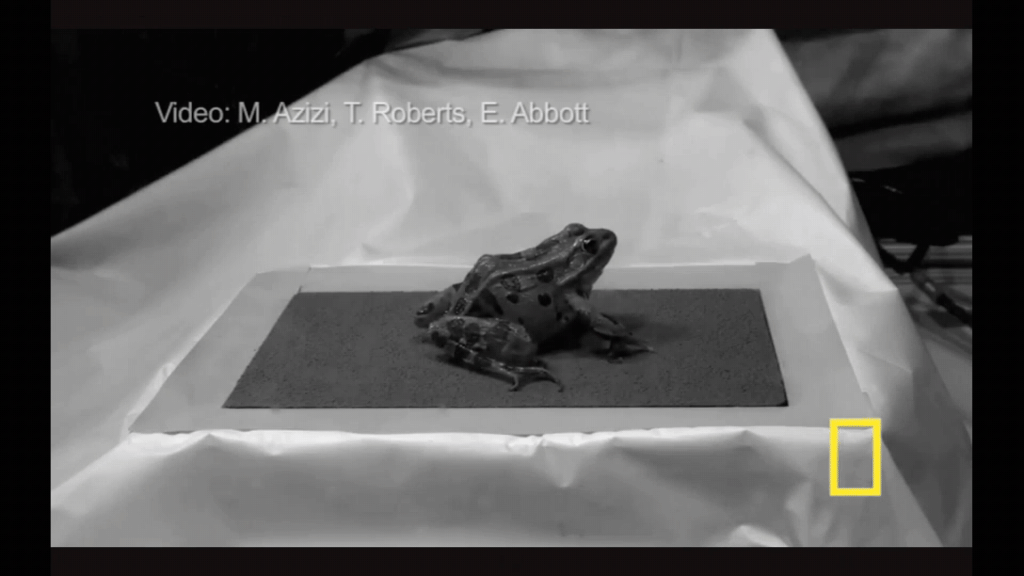
Jumping is powered by the large leg muscles which can make up an important part of the mass of a frog (33% in the stripped rocket frog). The leg muscles of frogs appear to be adapted to jumping. When jumping frogs contract their plantaris muscle by 30%. The plantaris extends from the tibiofibula to the foot and straightens the ankle when contracted. A 30% contraction is much higher that the typical range for muscle contraction in vertebrates. Most muscles only need to contract by about 5% to produce their maximal amount of force. Greater contraction results in sub-optimal force generation. The plantaris in frogs produce its maximal amount of force when contracted by 30% because they it is more elastic than typical muscles so its resting lenght is relatively long compared to other muscles.

Although the leg muscles are powerful, the force generated by a jumping frog far exceed the force generated by the jumping muscles alone. The force unaccounted by muscle contraction comes from the recoil of elastic tendons. Milliseconds before a frog’s takes off, the plantaris muscle starts to contract and stretches a tendon that attaches the muscle to the foot. The stretched tendon stores potential energy like a loaded catapult until the frog is ready to take off at which point the ankle joint opens rapidly propelling the frog.

Frogs land on their forelimbs so much of the impact of landing is absorbed by the forelimbs and sternum. Part of the sternum is cartilaginous which is presumed to help absorb the shock of landing. The bones of the forearm, the radius and ulna, are fused into a single bone (radioulna) which makes the bone more resistant to impact. It should be noted that not all frog species employ saltation as their primary mode of locomotion. Many species in fact seldom jump. Hopping appears to be the ancestral mode of locomotion in anurans. While some groups have adapted to walking, swimming or climbing, others have have adapted to leaping.
Limbless locomotion in snakes
Despite lacking limbs, snakes have adopted a wide range of lifestyles including, fossorial, arboreal, and pelagic. As a group, snakes have evolved various types of locomotion and most species can use several types depending on the environment. At the core of the locomotory system of snakes is 120 to 400 pre-cloacal vertebrae and long chains of segmented muscles and allowing for fine motor control along the snake’s body. The vertebrae of most tetrapods which articulate through the post-zygapophyse/prezygapophyse and the condyle/cotyle. The vertebrae of snakes have an additional joint between them: the zygosphene/ zygantrum. This joints further stabilizes the vertebral column and reduce twisting of the body when a snake bridges a long gaps.

The typical mode of terrestrial locomotion in snakes is lateral undulation, commonly called slithering in which a snake moves forward by pushing part of its body against fixed points on the substrate. During slithering, the whole body passes through the first push point like a train on tracks. Pushing against fixed points like rocks, roots, or branches creates both lateral and forward forces but the lateral forces on either sides cancel each other and the remaining forces push the snake forward.

In addition to their bodies, snakes use their ventral scales to gain purchase against the substrate. The ventral scales are broad and overlapping with their egde pointing towards the tail. Some snakes like the gray rat snake can slither up a vertical tree trunk by using only their ventral scales to grip on the bark.

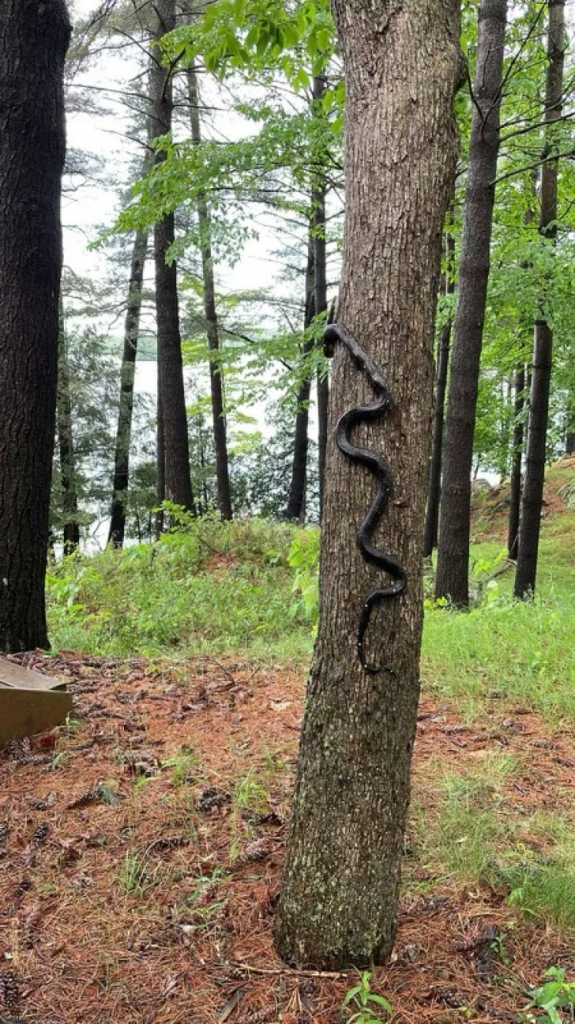
Snake also use their ventral scales gain purchase on smooth surfaces. Recent studies have also shown that snakes can raise the parts of the body not pushing to reduce friction.

Snakes employ other types of locomotion than slithering including concertina, and sidewinding. Concertina is used when lateral undulation is not possible such as in confined spaces (e.g. a burrow) or when climbing trees of moving on a narrow branch. As the name implies, concertina involves an accordion-like motion in which part of the body remains stationary while the rest moves forward. For instance, in a narrow burrow a snake may hold the posterior part of its body in place by pushing against the walls of the burrow while extending the anterior part of the body. The anterior part is then held in place by pushing against the walls while to the posterior part is pulled forward.
Sidewinding is used on substrate with low friction like mudflats or on loose substrates like sand. Although most snakes seems to be able to use sidewinding, it is most often associated with snakes living in sand dunes like the the sidewinder rattlesnake (Crotalus cerastes) found in the American Southwest. Sidewinding is mind boggling to watch and challenging to explain. Sidewinding snakes, as the name implies, move sideways. Typically the snake keeps two contact points with the substrate and throws the rest of its body forward. When the part thrown forward lands, it becomes a new contact point. Sidewinding snakes can more quite fast on loose substrates. Moreover, because only part of the body is in contact with the substrates at any point in time, sidewinding it reduces heat transfer by conduction which can be useful to reduce the risk of overheating in a hot desert.
Finally, snakes can move without bending their body. This is called rectilinear locomotion. While slow, this type of locomotion allows snakes to move in very tight space and to slowly sneak on prey. During this type of movement, the ventral scales are lifted and moved forward in waves. It’s almost like the legs on a centipede. In the video below, you see the substrate lighting up (purple) where the body is pushing against it.
Swimming
Many amphibians and reptiles need to move in water. One of the main challenges of swimming is coping with drag. Species that rely much on swimming thus tend to have a body shape that reduces drag (hydrodynamic). Snakes, crocodilians, tadpoles, and salamanders swim by sending waves down their entire body to generate thrust. This type of swimming is called undularory swimming. The tail often plays an important role in generating thrust in undulatory swimmers. Fully aquatic salamanders (e.g. mudpuppies, adult red-spottted newts, and larval salamanders) and sea snakes have laterally flattened tails to increase the surface area pushing against water. Some sea snakes even have laterally flattened body.

Northern water snakes are equally at home in water as they are on land. This species does not have laterally flattened body which would impede with their terrestrial locomotion but they can change the shape of their body based on their type of locomotion. When swimming, water snakes flatten their body laterally to increase the surface area pushing against water.

Turtles and frogs use drag-based swimming meaning that they push their appendages against the water to create thrust (like rowing). Both group primarily use their hind limbs to swim and both have large webbed feet to create the thrust. Frogs tend to propel themselves by “kicking” the water with both feet simultaneously whereas freshwater turtles use their limbs alternatively.
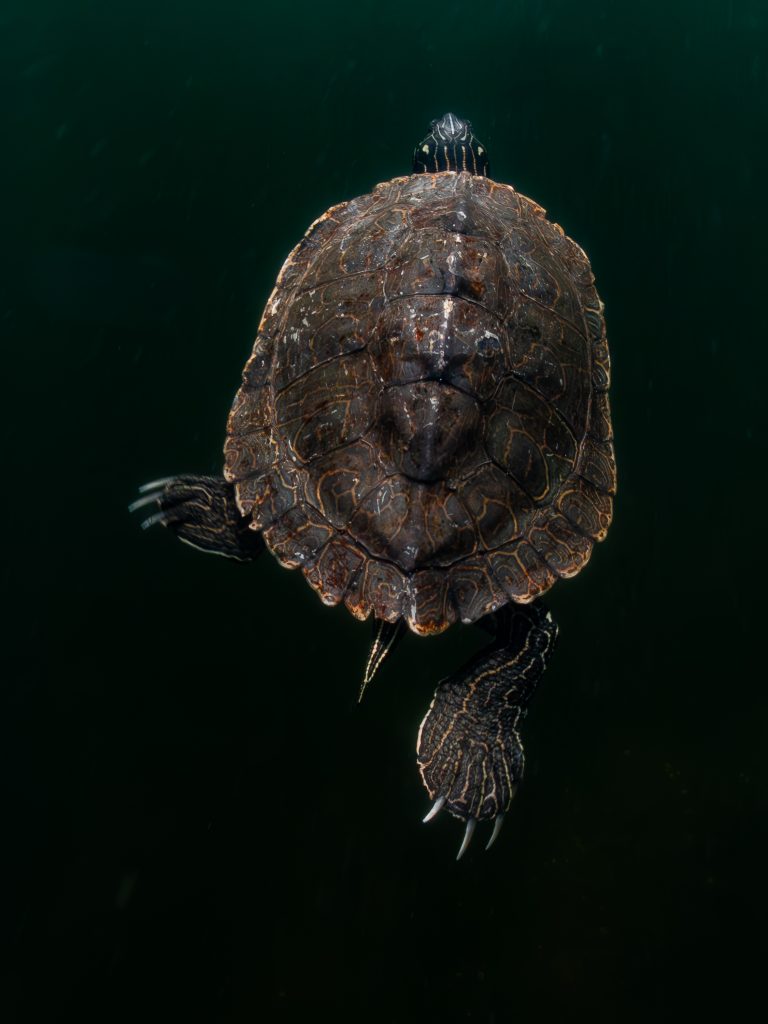
Freshwater turtles are negatively buoyant due to their heavy shell, meaning they naturally sink. To counteract this, turtles regulate their internal volumes of air and water. Unlike fish, they cannot expand or contract a swim bladder. Instead, they rely on their lungs and cloacal bursae. By inhaling or exhaling, turtles adjust lung volume, directly influencing buoyancy. Cloacal bursae can hold water, acting as ballast to offset lung air. By varying the water content in the bursea, turtles can achieve neutral buoyancy without constant lung adjustments, conserving energy during dives.

Sea turtles have an entirely different type of swimming than freshwater turtles. Sea turtles use their forelimb which have been modified into flippers like birds use their wings to fly. Thus their mode of propulsion is not considered drag based but lift based. Sea turtles flap their flippers in unison. On the downstroke, the flipper pushes water backward and downward, creating forward thrust. On the upstroke, the flipper rotates slightly, maintaining a positive angle of attack so it still generates lift. Because both strokes produce forward force, swimming is smoother and more efficient than drag-based paddling.
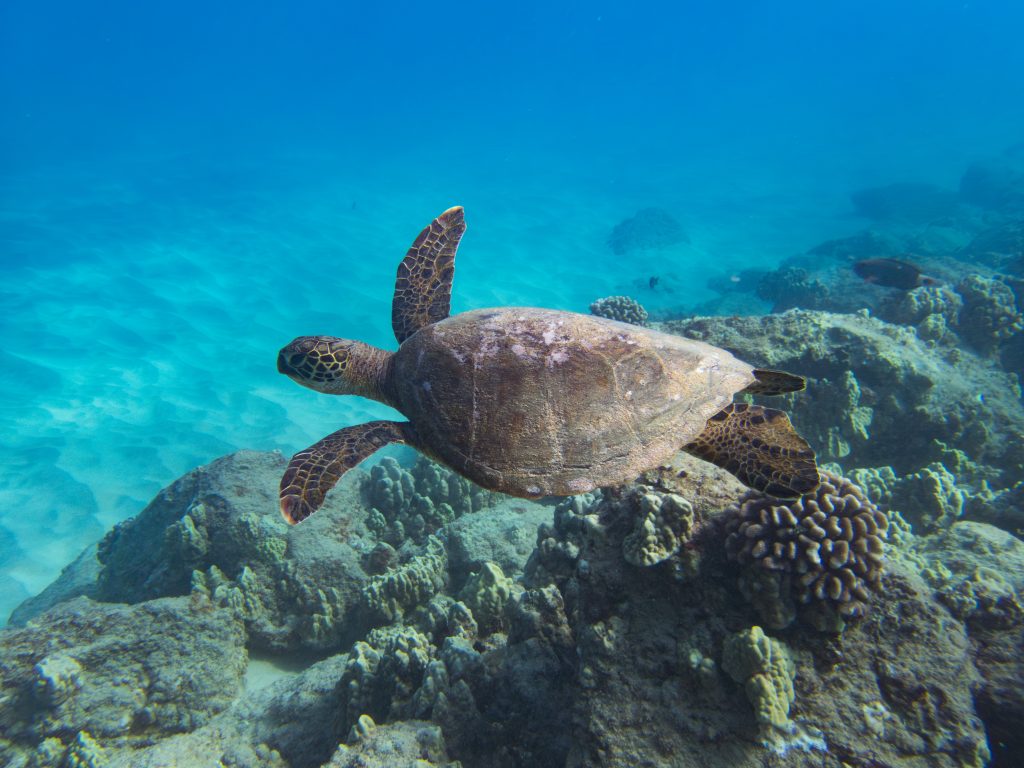
:
Adhesion
Several species of amphibians and reptiles can cling to smooth surfaces including tree frogs (Hylidae) as well as some geckos (Geckonidae), and iguanids (e.g. Anoles). In frogs, adhesion is largely achieved by the production of sticky secretions by the toe pads. The toe pads have hexagonal cells separated by deep grooves. Mucus is secreted between the cells. Interestingly, sticky toe pads have evolved independently is a few families of frogs but the structure of the toe pads is very similar between families.
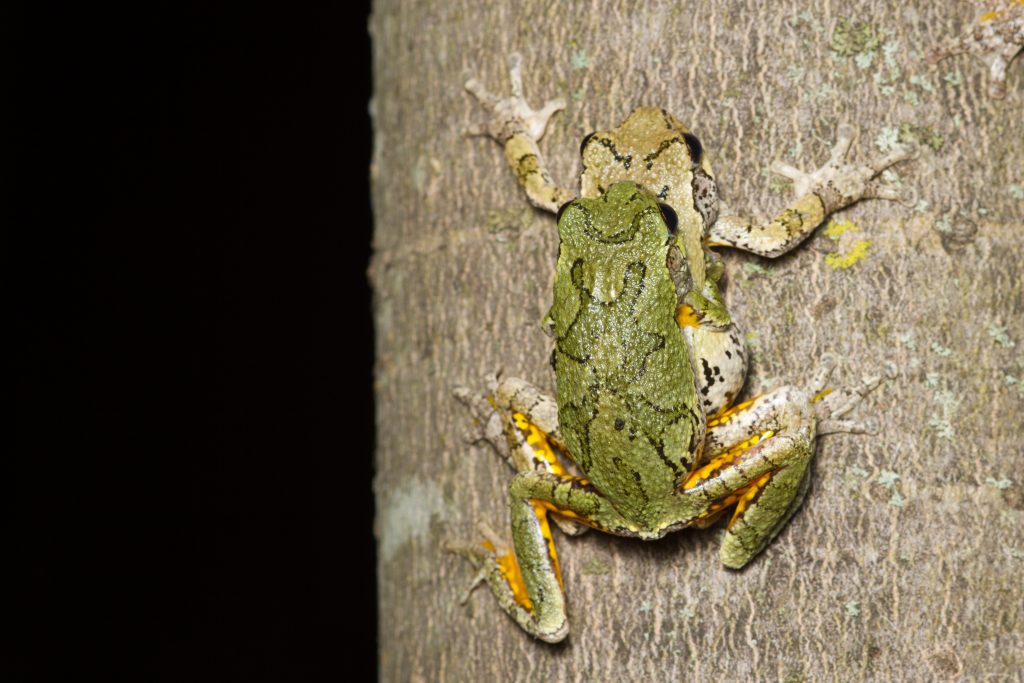

Geckos (and a few other groups of lizards) use a dry adhesion mechanism that does not rely on mucus. The toe pads of geckos have scale like structures called lamellae. Each lamella is line with microscopic hairs (setae) and the tip of each hair splits into multiple branches with a flat ending called a spatula. Each spatula are a fraction of a micron and get close enough to a surface so that the molecules of the spatula and the surface attract each other through Van de Waals forces. Each spatula does not have much adhesive potential but a gecko foot can have 500 000 setae each with multiple spatulae.
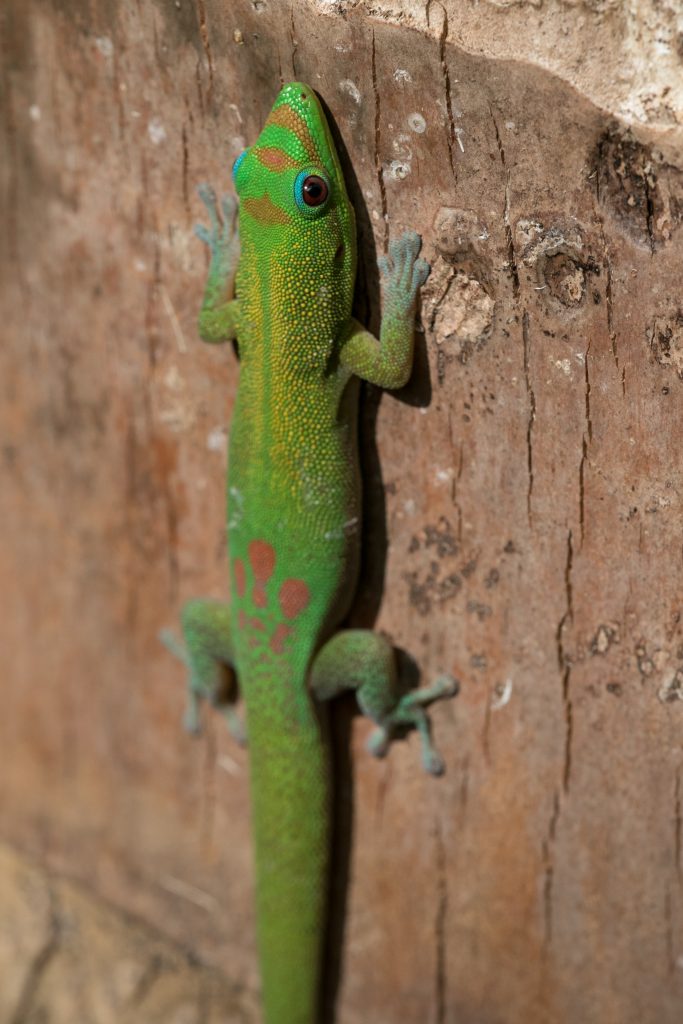

References
Jurestovsky, D., Jayne, B. & A., Henry. (2020). Experimental modification of morphology reveals the effects of the zygosphene-zygantrum joint on the range of motion of snake vertebrae. The Journal of Experimental Biology. 223. jeb.216531. 10.1242/jeb.216531.
Mayerl, C., Capano, J., Moreno, A, Wyneken, J., Blob, R. & Brainerd, E. (2019). Pectoral and pelvic girdle rotations during walking and swimming in a semi-aquatic turtle: testing functional role and constraint. The Journal of Experimental Biology. 222. jeb.212688. 10.1242/jeb.212688.
Media Attributions
- tumblr_o34501szfg1qckzoqo1_500
- locomotion-2
- locomotion-4
- locomotion-6
- frog jump
- Untitled.001
- Picture1
- Week 10_Locomotion.001
- locomotion-9
- locomotion-13
- OLYMPUS DIGITAL CAMERA
- locomotion-12
- locomotion-11
